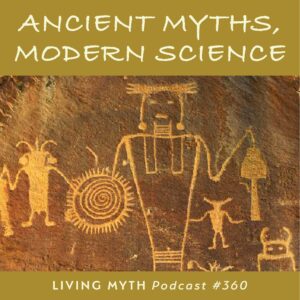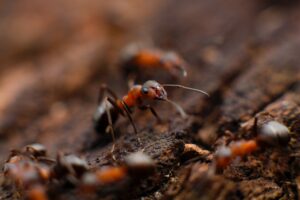Can’t See the Forest for the Trees?
Look around! Wherever our gaze lands in our natural world, the beings with whom we share this planet teach us about adaptation, resilience, and flexibility. But often we can’t see the forest for the trees.

It turns out ants have been showing us how to survive in times of crisis for longer than human beings have walked the earth. It’s a topic that is top of mind as I explore how my immigrant ancestors adapted to the Canadian west in the 1920s. Most importantly, what wisdom do those forebearers, who found themselves on the unique settlement of Namaka Farm in southern Alberta, have to share about intercultural and ecological relationships that are relevant almost a century later.

Michael Meade’s Living Myth podcast episode, “Ancient Myths, Modern Science,” talks about how ants, tiny creatures who began to proliferate around 100 million years ago, have survived. For example, a single ant will drown in flood waters, but a group can create a raft that allows them to float for weeks. He recounts Hopi mythology that credits ants with guiding them to refuge and sustenance in subterranean caves. Ants taught humans how to find and store food. It is no surprise that ancient Hopi dwellings resemble giant ant mounds.
Ant colonies survive because of the division of labour between individuals. They demonstrated resilience, flexibility, and adaptability that taught them new ways of being. In “Moving Targets: Collective Decisions and Flexible Choices in House-Hunting Ants,” Franks et.al, cite examples of unique tasks—like protein foragers, honeydew collectors, and nest builders—requiring specific skills, that when divided amongst its members, sustain the colony. Meade describes tracking ants who leave a scented trail that direct others to food and home. The colony couldn’t survive without individuals and their unique abilities and gifts. Nor could an individual survive alone, especially in times of crisis.

The Russlaenders (German-speaking Russian Mennonites) who arrived on Namaka Farm were no strangers to change, crisis, or the strengths of their communities. Many had stepped into the unknown after bidding a final good-bye to family and a place they had called home for more than a century. Their departure, beginning in 1923, came after a revolution, years of civil war, famine, and epidemics. Canadian Mennonites successfully lobbied the government to rescind a 1919 Order in Council banning further Mennonite immigration. They mobilized to help them leave what had become the U.S.S.R., now Ukraine.
Once in Canada, new crises awaited the settlers, many destitute and indebted. Although some spoke rudimentary English, most spoke High German as their first language, Low German at home, so learning the language became a priority. Many had held professions other than agriculturalists although all had to farm for five years. Likewise, they were not entitled to public funds during this time. Like everyone in the west, they would soon face serious droughts, hailstorms, and the collapse of commodity prices.
While some arrived in family groups, others who settled on Namaka Farm were strangers to each other. Their survival depending on adapting from the once-autocratic regime they were familiar with to a colonial structure. Those who were not agriculturalists, had to learn how to farm. All had to adapt their methods and implements to different soil and climatic conditions. Out of necessity, the first arrivals on the Farm worked for the first years as tenants and lived communally in crowded quarters—in deference to their preference for individual holdings.
Stories passed down to descendants indicated a harmonious coexistence, yet even though they were in a land of peace and freedom, their difficulties were far from over. My research uncovered relationships between the land and its peoples that were far more complex and unbalanced than anticipated. In a conversation with Dad recorded in 2015, I asked how it was that the people of Namaka and their neighbours got along. “Simple,” he said. “We needed each other so much.”

Ants teach us that no matter where we look in the natural world, lie lessons about new ways of being together. They are especially relevant when we are facing collective stress. By example, these tiny beings teach us how to form sustainable, harmonious, and mutually thriving relationships with all beings.
By the time my ancestors and other settlers arrived in the west in the 1920s and 30s, decades of colonization and agricultural development in the name of economic expansion, had created structural imbalances that had devastated Indigenous Peoples and other racial and ethnic minorities and degraded the land. The tenuous first years were marked by continued hardship, poverty, and at times, friction.
We’re still learning how to live together sustainably. Perhaps rather than trying to control the rest of nature, it’s time to adopt the wisdom that surrounds us.
Can’t see the forest for the trees? Sometimes the tiniest beings with ancient wisdom are waiting to show us the way. If we’re missing the messages from ants, what else are we missing that is right in front of us?
Sources:
- Franks, Nigel R., James W. Hooper, Mike Gumn, Tamsyn H. Bridger, James A. R. Marshall, Roderich Groß, and Anna Dornhaus. “Moving Targets: Collective Decisions and Flexible Choices in House-Hunting Ants.” Swarm Intelligence 1, no. 2 (November 15, 2007): 81–94. https://doi.org/10.1007/s11721-007-0007-8.
- Meade, Michael, “Ancient Myths, Modern Science,” Living Myth Podcast, https://www.mosaicvoices.org/episode-360-ancient-myths-modern-science
- “Ants division of labor,” https://purcelllab.ucr.edu/pdfs/Teaching_Resources/division_of_labor.pdf
Photo credits:

I am currently re-reading Anne Lamott’s “Bird by Bird,” which speaks a great deal about truly seeing the world around us. Good advice.
I love Anne Lamott’s writing! Thanks Jeff.